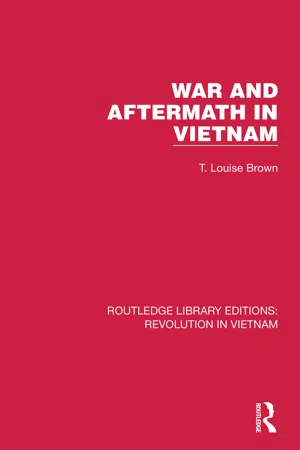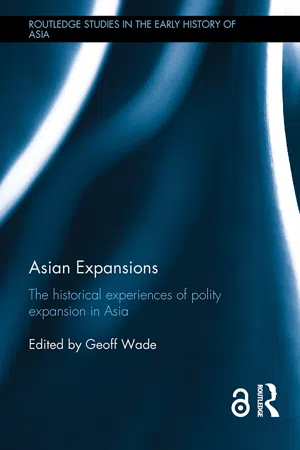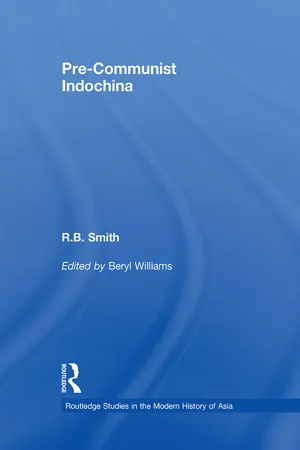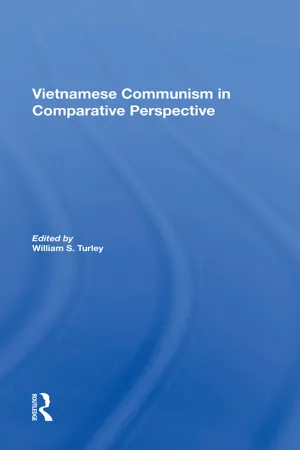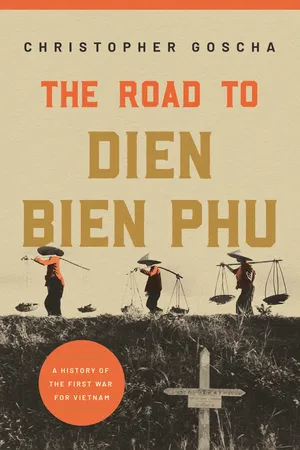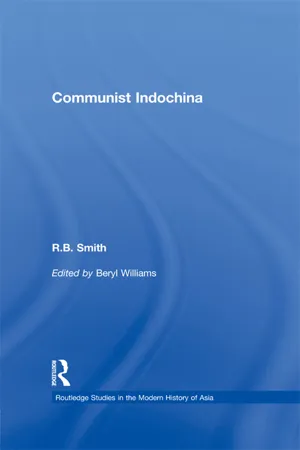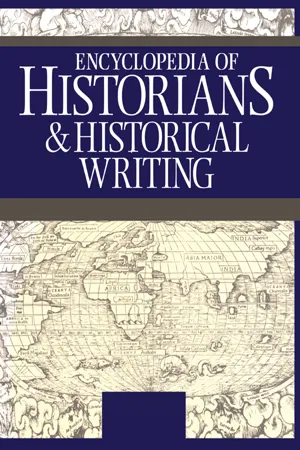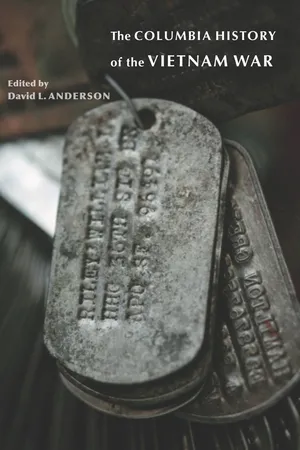History
Imperial Vietnam
Imperial Vietnam refers to the period when Vietnam was ruled by a series of dynastic emperors, beginning with the Đinh dynasty in 968 and ending with the Nguyễn dynasty in 1945. This era saw the development of a distinct Vietnamese culture, the expansion of the country's territory, and the adoption of Confucianism as a guiding ideology.
Written by Perlego with AI-assistance
Related key terms
11 Key excerpts on "Imperial Vietnam"
- eBook - ePub
- T. Louise Brown(Author)
- 2021(Publication Date)
- Routledge(Publisher)
Wiegersma 1988 :50). By limiting the influence of the mandarinate and attempting, if not always succeeding, in enforcing periodic land redistributions, the emperor reallocated to the poor some of the land appropriated by wealthy individuals. Far from being examples of the social concern of the court, these acts were designed to ensure its self preservation, firstly by quelling peasant unrest and secondly by weakening the power and influence of aspiring individuals whose cumulative strength could threaten the imperial dynasty.The emperor stood at the apex of the Vietnamese social hierarchy. Although not of divine status, he was the mediator between man and God and all his subjects owed him allegiance. But, despite the idealization of loyalty to the emperor, the weakness of central authority and the inevitable dynastic cycle resulted in long periods of endemic civil strife. Thus, in the sixteenth century, Vietnam was wracked by internecine conflict which culminated in the division of the country, initially for fifty years and then, after an interlude of three decades, for a period of 150 years. During the second period of political division, dating from 1620, each half of Vietnam was headed by a regionally based dynasty which formed a chua or overlordship in a style similar to that of the shoguns of Japan. As a result, while the Trinh family ruled the north and the Nguyen the south of Vietnam, the emperor was reduced to the status of a puppet under the control of the Trinh.The Nguyen state encouraged an ongoing southward migration of the Vietnamese people. Population pressure in the Vietnamese homeland of the Red River Delta had become so serious by the fifteenth century that a ‘March to the South’ began. It took hundreds of years for this human frontier to move down the length of modern day Vietnam but by the eighteenth century it was gradually spilling out into the vast, untamed Mekong Delta.The importance of this migration lies in the nature of the new settlements that were established. Unlike their forefathers in the north, the frontier people settling the fertile lands of the south did not build tightly knit communities. Without the restrictions imposed by over-population they created dispersed villages which spread out, linear fashion, along waterways and newly built canals. The more even flow of the Mekong River rendered elaborate flood prevention methods unnecessary and, therefore, the degree of corporate activity within the community was reduced (Cotter 1968 :20–1). Consequently, the fewer demands placed upon collective action resulted in a diminution of the ideal of the xa - eBook - ePub
Asian Expansions
The Historical Experiences of Polity Expansion in Asia
- Geoff Wade, Geoff Wade(Authors)
- 2014(Publication Date)
- Routledge(Publisher)
7 The Vietnamese empire and its expansion, c.980–1840 Momoki Shiro DOI: 10.4324/9780203481998-7When the state of Đại Cồ Việt1 was established in the tenth century, it inherited only the territory (I use the term “territory” in a broad sense, regardless of the nature of rule) of the Chinese protectorate of Annan, which covered present-day northern (Bắc Bộ) and north-central (Bắc Trung Bộ) Vietnam north of Ngang Pass, but which did not include present-day Tây Bắc or the northwest region. The maximum extent of the territory at that time was around 110,000 square kilometres. However, when Nguyễn Vietnam surrendered to France in the late nineteenth century, the territory it claimed to control had more than tripled to over 370,000 square kilometres, similar in extent to the present-day Socialist Republic of Vietnam, stretching from the Chinese border to the Gulf of Thailand. For this reason, the territorial (mainly southward) expansion realised by successive “Vietnamese” dynasties (Đại Cồ Việt, Đại Việt and Việt Nam) forms one of the major themes in conventional Vietnamese historiography.2 Alongside glorious resistances to foreign (mainly Chinese) invasions, the expansion was regarded as an expression of the vitality of the Vietnamese nation. Vietnam’s Chinese-modelled state system, supported by neo-Confucianist social and family norms, was often argued to be superior to that of its “Indianised” neighbours, while in socio-economic terms, fierce demand for arable land among peasants living in over-populated lowland villages was often thought to have been the key factor in the expansion.However, a thorough revision is now required. First, there have been few detailed studies of the process of expansion. Moreover, most of the earlier studies were conducted only from the viewpoint of the Viet people.3 This situation contrasts sharply with the research into the resistance to China, of which many details have been clarified from both sides. Second, the earlier explanations outlined above can no longer be maintained in the face of recent developments in Vietnamese and broader Asian historical research. The expansion brought about a diversity of “Vietnameseness” in different regions rather than the development of a single homogeneous nation.4 Arguments about the Chinese-modelled state system make sense only when the concrete historical context and the process of localisation are closely examined.5 Images of “traditional” over-populated villages and great hydraulic works can be adequate only in the early modern phase,6 while more attention should be paid to commercial interests and the struggle for hegemony over trade.7 - eBook - ePub
- R.B. Smith, Beryl Williams, Beryl Williams(Authors)
- 2014(Publication Date)
- Routledge(Publisher)
The Nguy ễ n avoided almost certain elimination by securing the governorship of Thu ậ n-Hóa (the Hu ẽ area) in 1558. There they laid the foundations for what became virtually a separate kingdom in the seventeenth and eighteenth centuries. Thus the history of Vietnam in the sixteenth century was even more disturbed by internal political conflict than that of England had been during the so-called Wars of the Roses. By 1558, the year of Elizabeth’s accession, Vietnam had entered a period of political division which would end only in 1802. III In the broad sweep of world history, it is easy to lump together countries such as England and Vietnam had become by 1500 under the general heading “traditional societies.” But when it comes to making detailed comparisons, comparability of scale and economic similarities must be set against cultural differences as great as any that were to be found in the world of 1500. It is not enough to attach labels to societies, be they universal epithets such as “traditional” or cultural identities such as “Christian” and “Confucian.” It is necessary to compare in detail actual situations and social and political arrangements. Both these countries were monarchies and both have been described, in very different contexts, as “despotisms.” The Vietnamese monarchy belonged to the type which K. A. Wittfogel has dubbed “oriental despotism.” 5 The power of the king was quite arbitrary, untrammelled by such limitations as the need to obtain parliamentary approval for taxation and other impositions on his subjects, or by the need to borrow money from rich merchants and financiers who enjoyed sufficient independence to charge him high rates of interest. Nor were there any restraints or precedents which obliged him to respect the rule of law; nor any Church to insist that in certain spheres the king had no jurisdiction at all - eBook - ePub
Guerilla Capitalism
The State in the Market in Vietnam
- Lan Nguyen(Author)
- 2009(Publication Date)
- Chandos Publishing(Publisher)
A rich variety of artefacts have been found – big bronze drums, lamps, bells, pearls and elaborately decorated pottery – dated between 3,000 and 4,000 years ago, which suggest a prosperous and lively society (Molyneux, 1995). The high level of civilisation achieved during this period led to the formation of a cohesive society, able to resist and fight against powerful invaders and keep its identity during the next two thousand years. Following invasion, from the first century BC to the tenth century Vietnam fell under the rule of the Chinese empire and consequently, was heavily influenced by Chinese culture and institutions. The Vietnamese gained independence from Chinese rule in AD. 939 and thereafter enjoyed a period of independent development during which it was ruled by two dynasties: Ly (1009-1225) and Tran (1225-1400). Between 1407 and 1427, Vietnam once again fell under Chinese rule until their expulsion by a great leader Le Loi who established the Le dynasty in 1428. Vietnam enjoyed the first period of the Le dynasty, especially the thirty seven year reign (1460-1497) of another great king Le Thanh Tong. Afterwards, however, the dynasty fell into decline and whilst it retained control, for the next three centuries recession and internal conflicts sapped the wealth and energy of the country. One of the features of this period was the expansion and standardisation of the Vietnamese writing system (Nom) which was transcribed from the Chinese. The later decades of the eighteenth century were dominated by the Tay Son rebellion. The Tay Son era is poorly understood in Vietnamese history (Jamieson, 1993). The Tay Son, however, are widely regarded as progressive and open-minded and were responsible for making Nom the official writing system. The Nguyen dynasty began in 1802 and was responsible for making Confucianism the foundation of the national culture - eBook - ePub
- William S Turley(Author)
- 2019(Publication Date)
- Routledge(Publisher)
Phan Boi Chau, Phan Chu Trinh 1920s-1940s VNQDD (Nguyen Thai Hoc), ICP (Nguyen Ai Quoc/Ho Chi Minh) 1945 The August Revolution, Vietnam declared independent 1940s-1970s Dien Bien Phu, Tet offensive 1968, 12 days of December 1972, Spring offensive (Ho Chi Minh campaign) 1975 1976-1976 Establishment of the SRVinfluenced by the contemporary Ming dynasty and included the bureaucratic form of direct administration, Neo-Confucianism as the ideology of the state, and universalistic selection for office via examination.The "Chinese model" (with certain changes) lasted as the ideal of Vietnamese government for four centuries. It reached its greatest reality in Vietnam during the middle decades of the nineteenth century, only to collapse before the French thrust. The colonial regime retained the kings, though in the process the monarchy lost its appeal for most of the Vietnamese people. What is important to realize is that certain themes in Vietnamese culture, some of them linked to the ancient myths, survived both the imposition of the Chinese ideal and the French conquest.Nevertheless, the immediate question arising from the modern political crisis was: what form will the new Vietnam take? The answers offered were numerous and came from ail points of the political spectrum. A. B. Woodside provides a nice sample of the responses from the past hundred years in his book, Community and Revolution in Modern Vietnam , as also does William J. Duiker's The Rise of Nationalism in Vietnam, 1900-1941 .5 From the 1940s to the 1970s, the number of alternatives narrowed until May 1, 1975, marked the adoption of the Communist model. Communism had been successfully merged with the indigenous themes of Vietnamese culture to form the basis for a new political regime in Vietnam.Such a view provides reality to the old phrase continuity and change. A strong theme of continuity must be recognized in Vietnamese civilization, as simultaneously new choices changed the form taken by that civilization. It is not so much a question of the old and the new, "the formalistic dichotomy of tradition and modernity," as it is of a continuing series of transformations of indigenous culture and society.6 - eBook - ePub
The Road to Dien Bien Phu
A History of the First War for Vietnam
- Christopher Goscha(Author)
- 2022(Publication Date)
- Princeton University Press(Publisher)
Decolonization, however, does not mean that the newly independent states will not remake themselves in imperial form. Like the Americans who left the British empire in the late eighteenth century only to create their own empire stretching across the continent and further, the Vietnamese began expanding their Red River Vietnam southwards. To this end, they often used modern Chinese weapons, statecraft, and colonial ideology of a “superior” Confucian kind (Vietnamese revolutionaries were to cast communism in uncannily similar terms when pitching it to the Laotians, Cambodians, and others in the mid-twentieth century). As their armies, administrators, and settlers moved out of the Red River basin, the Vietnamese alternated between “direct” and “indirect” forms of rule over distant, multiethnic peoples, they tested cultural assimilation, and developed their own “civilizing mission” to justify it all. By heading south, the Vietnamese vanquished the Cham people, who ruled much of today’s central Vietnam, subjugated the Khmers in the lower Mekong Delta, and began to control a host of non-Vietnamese peoples living in the surrounding highlands. Whether by force, persuasion, or settlement, a Vietnamese colonial state expanded slowly but surely down the coast to the point of Ca Mau in the Gulf of Thailand. This is how modern Vietnam gradually acquired its recognizable S-like shape.Imperial Vietnam had other forms too. At the start of the nineteenth century, after a long civil war, the leaders of the Nguyen dynasty unified Vietnam, established their capital in Hue, then pushed Vietnam’s territorial expansion in more westerly directions. More of this took place during the 1830s, when an expansionist-minded emperor, Minh Mang, sent his army into the neighboring kingdom of Cambodia and incorporated it into what he called the “Greater South,” the Empire of Dai Nam. The Vietnamese emperor sent Confucian-trained governors and civil servants to administer Cambodia. The court taxed Cambodians, put many of them to work building roads and canals, and encouraged both Vietnamese and Chinese settlers to go further west. The Nguyen dynasty also expanded its territorial control into today’s eastern Laos and further into the highland areas of northern and central Vietnam. By the mid-nineteenth century, Minh Mang’s Dai Nam had already started to look a lot like French Indochina. (See Map 2 - eBook - ePub
- Peter Church(Author)
- 2017(Publication Date)
- Wiley(Publisher)
11 VietnamThe Vietnamese were ruled by the Chinese for over a thousand years, from the 2nd century BC until the 10th century AD . After winning their independence, the Vietnamese continued looking to China as their cultural model, their prime source of concepts of government, social organisation, and the arts. Culturally, Vietnam thus belonged to the Confucian world of East Asia, which distinguished it sharply from neighbouring states with Theravada Buddhist or Islamic cultures. The difference in cultural outlook between Vietnam and her South‐East Asian neighbours has long contributed to conflict in the region.But the Vietnamese regard for China also made for conflict within Vietnam itself. It proved difficult to reconcile with another Vietnamese impulse—to protect their distinctive character as a people and to uphold uniquely Vietnamese cultural traditions. Whether to adopt or to resist Chinese ideas became a perennial source of social and cultural stress within Vietnam's ruling class, and also between ruling class and people.The Vietnamese state was an expanding one, which only intensified such cultural stresses though it took 700 years. The expansion, known as the “march to the south,” eased the country's population pressures and made Vietnam a major power in South‐East Asia. But it also bred deep regional differences and rivalries within Vietnamese society. Vietnam in the 19th century was in poor shape to face the challenges posed by the West's political, economic, and cultural expansion.The Western impact, in the shape of French colonial rule and subsequent American intervention, aggravated the historic tensions and also cut bitter new divisions in Vietnamese society. Communism in Vietnam, as in China, won wide popular support, with its promise of national independence and a reintegrated and just society. It delivered on the first promise; it failed on the second. As in China, communism in Vietnam as an overarching state ideology now drifts uncertainly, though most observers are optimistic about the future of Vietnam's 94 million people living in a state under Communist Party control but with a free‐enterprise economy. - eBook - ePub
The Rational Peasant
The Political Economy of Rural Society in Vietnam
- Samuel L. Popkin(Author)
- 2023(Publication Date)
- University of California Press(Publisher)
(This would have marked effects on the patterns of rebellion and revolution in the twentieth century.) The attempts of the Vietnamese emperors to politically integrate their domain were continually thwarted by their contradictory, short-run interests in preventing the emergence of regional contenders and by the nature of their allegiance to Chinese political and cultural forms. As Alexander Woodside has so aptly noted, “Thanks to its two thousand years of elitist homage to a foreign culture, in no country in the world is differential acculturation more psychologically invidious and politically dangerous than in Vietnam.” 108 RELIGION AND POLITICS The Nguyen dynasty’s concern with orthodoxy, their fear of regional power bases, their efforts to give village notables a vested material interest in the system, their policies designed to prevent mandarins from gaining personal control of villages, and their efforts to control printing all highlight the basic fact that Vietnam, despite strong ethnic-linguistic identity, was a cultural battleground where a Confucian court and bureaucracy tried incessently to suppress political-religious diversity. Contrary to some interpretations, 109 cultural integration was not a reality, but a goal. 110 Constant efforts were made to domesticate the country to acceptance of the forms, roles, and structures of a bureaucratic Confucian state and even, when and where it was possible, to promote the internalization and acceptance of Confucian codes. The Tay Son rebellion at the end of the eighteenth century established a regime that was significantly different from that of its predecessor - eBook - ePub
- R. B. Smith, Beryl Williams, Beryl Williams(Authors)
- 2012(Publication Date)
- Routledge(Publisher)
By starting in the 1890s, of course, we are taking the French presence largely for granted. It is worth suggesting, none the less, that conquest by France might conceivably have been avoided if the court of Hué had been more accommodating to the Europeans in the mid-1850s. At that time France and Britain were cooperating in a diplomatic effort to ‘open up’ the ports of China, Vietnam, and Siam. It would have been possible at that stage for ‘Dai Nam’ to agree to treaties with both those powers, then to follow the same path with other Western governments. It was by accepting such treaties with several countries almost simultaneously — Britain, France, the United States, Denmark, the Hanseatic League, etc. — that Siam was able to escape colonial conquest by any single power during the later years of the nineteenth century. Even China had treaties with enough countries to retain its sovereignty, although not all of its power, until the formal establishment of an ‘open door’ policy after 1898. Vietnam, however, rejected the advances of both the French ambassador Charles de Montigny and the British official Thomas Wade in 1856–57. By refusing to trade with foreigners at all at that critical juncture, Vietnam found itself, by 1859, having to deal with the colonial ambitions of a single European power. Thereafter, Britain and other Western powers were content to leave France to pursue its own ambitions in Vietnam and Cambodia; and up to a point, even in Laos. By the start of our period, therefore, in the 1890s, Vietnam was gradually coming to terms with an unprecedented form of foreign domination which, having established itself in the South a generation earlier, was now beginning to make itself felt in the Centre and North.During the period since the 1890s it is possible, from Vietnam’s own point of view, to identify three — perhaps four — key moments of social and political discontinuity. The first such moment occurred around 1916: the year which saw the final abolition of the Confucian examination system as a means of recruiting Vietnamese ‘mandarins’. Until that point there was still some sense of continuity with a tradition dominated by classical Chinese texts and an imperial bureaucracy. A notable Hué scholar of the early French period was Cao Xuan Duc (1842–1923): governor of a key area of ‘Tonkin’ in the early 1890s, then head of the Office of History (Quoc Su Quan) from 1903 to 1908 and subsequently minister of education (1908–13).2 - Kelly Boyd(Author)
- 2019(Publication Date)
- Routledge(Publisher)
Historical writing becomes much richer for the modern period. There are several good surveys of this era, including those by Woodside, Buttinger, Neil Jamieson, and Ngo Vinh Long as well as the essays collected by David Elliott and Walter Vella. The gradual colonization by French imperialism, and the (often negative) impacts this had on Vietnam's political evolution, social structure, and economic patterns, generated a number of studies. The French imperial enterprise has been analyzed by, among others, John Cady, Milton Osborne, and Pierre Brocheux and Daniel Hémery. But even after conquest it took the French an additional fifteen years of bloody repression to "pacify" the country against a heroic resistance; this opposition has been well studied by Truong Buu Lam, Helen Lamb, and David Marr.The social and economic aspects of French colonialism, including the effects on village life, have been the subject of numerous studies, including those by Ngo Vinh Long, Hy V. Luong, and Pham Cao Duong (all writing on the transformation of the peasantry), Brocheux (a study of the Mekong delta), Nguyen Van Phong (early colonial social change), Donald Lancaster, and Martin Murray (on capitalist development). Both Marr and Woodside have brilliantly deciphered the complex intellectual and cultural developments of the period, while Osborne has outlined political change. The nationalist surge that commenced after the turn of the century and accelerated before World War II, most significantly in the form of the communist movement, has generated a considerable literature. William Duiker's various books constitute an essential baseline for understanding, augmented by Huynh Kim Khanh's incisive study of Vietnamese communism. The best biography of communist leader Ho Chi Minh is by Jean Lacouture. Mention should also be made of the works by John T. McAlister and Paul Mus, Ken Post (an exhaustive 5-volume study of the Vietnamese revolution), Hémery, Hodgkin, and Hue-Tam Ho Tai (who writes on noncommunist radical traditions).- eBook - ePub
- David Anderson(Author)
- 2010(Publication Date)
- Columbia University Press(Publisher)
Gia Long, because of Pigneau’s help and because he was aware of Western power, tolerated the presence of French missionaries in his country, but he and especially his successors were hostile to Christianity. Increasing persecution of missionaries and the West’s growing appetite for markets and resources in the nineteenth century caused France to send a naval force to Tourane (Danang) in 1858. From then until 1897, in a piecemeal fashion, France used military force to create what it called the Indochina Union, headed by a French governor-general in Hanoi. French Indochina consisted of five parts. In 1862, Emperor Tu Duc ceded Cochinchina, the area around Saigon, to France as a colony. Annam (central Vietnam around Hue) and Tonkin (northern Vietnam around Hanoi) became French protectorates in 1883. Paris also established protectorates in Cambodia in 1862 and Laos in 1893.French colonial rule in Vietnam was incredibly illiberal, narrow-minded, and destructive. The partitioning of Vietnam into three pays (countries), as the French called Tonkin, Annam, and Cochinchina, reversed centuries of Vietnamese efforts to create national unity. The Nguyen emperors had themselves administered their elongated country through three ky (regions) that were roughly analogous to the pays, but where the emperors sought to use this structure to promote unity, the French desired division. The colonial authorities even outlawed the use of the name “Vietnam.” This colonial-enforced regionalism magnified cultural differences that had already existed from the March to the South, which brought Chams, Khmers, and others within Vietnam’s borders. Vietnam’s historical difficulty in achieving internal unity in the face of external threats was once again manifest.The French governors sought to protect their authority by depriving the country of its native leadership. Giving their program the high-sounding name mission civilisatrice
Index pages curate the most relevant extracts from our library of academic textbooks. They’ve been created using an in-house natural language model (NLM), each adding context and meaning to key research topics.
